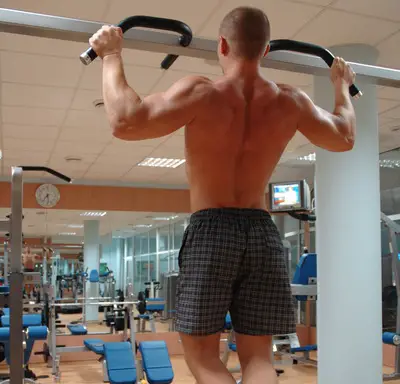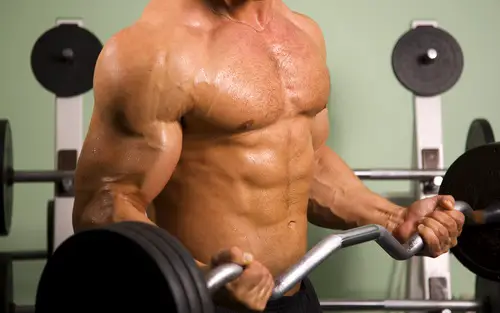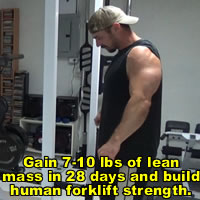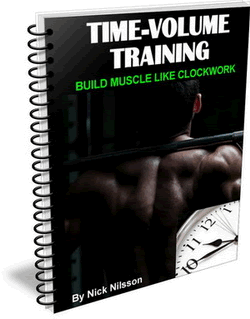By Nick Nilsson
Author of Time-Volume Training
Breathing is one THE most often overlooked pieces of the puzzle when it comes to weight training.
And it can have a tremendous impact on the results you get from your training.
Here's the thing that a lot of people don't know about breathing...different exercises require different breathing strategies.
Yep, how you breathe in a heavy squat is not even close to how you should breathe while doing a pulldown.
So here's a rundown of how to breathe while doing some of the more popular exercises (I will assume your form is generally good - going in depth into proper form for each exercise would make this a book instead of an article!).
** Please note, if you have high blood pressure or any issues with holding your breath (e.g. you easily get light-headed), you'll need to adjust these breathing recommendations accordingly. These instructions (for a few of the exercises, at least) are intended for those who don't have issues with short periods of breath holding.
1. How to Breathe When Doing Squats
When you're performing Barbell Squats, as you start the descent, inhale deeply so that you complete the inhalation by the time you're about halfway down. Hold your breath from this point on, all the way to the bottom and then about 1/3 to 1/2 of the way as you come back up.
Then exhale until you come all the way to the top. The reason you want to hold your breath like this is to maximize the stability of your abdominal region.
Breathing in or breathing out (especially out as you come up out of the very bottom), will destabilize the core area. To maximize strength and power, your muscles need a stable platform to work from. Keeping that solid core will also save your lower back from strain because more tension will held in the abs rather than being forced onto the lower back.
One of the key things I've found in my own squat is that core strength (in the frontal abdominal wall) is a HUGE part of successfully coming out of the bottom. If I breathe out at the bottom, I'm done. But if I save that exhalation until after I get past that point where I need maximum core stability, I'll hit the lift and power through that sticking point.
2. How to Breathe When Doing Bench Press
Improper breathing on the bench press is one of THE biggest reasons people are weak on this lift. If you breath wrong, you lose that stability (just like in the squat) and don't provide your body with a solid platform from which to move the weight.
This technique applies to heavier to moderate-weight benching - it's not as critical on the lighter, higher-rep training to follow it as is because the load is a lot less.
Picture yourself at the top of the movement with the barbell locked out. Now lower the bar, inhaling a deep breath as you come down. Here's the key...you should finish taking in that breath by the time you're halfway down (around your sticking point). This is important for torso stability.
Hold your breath during the bottom phase of the movement, just like in the squat. If you start breathing out right at the bottom, you will not only destabilize your torso, which will change the leverage in your shoulders, it'll also sink down your chest and flatten your shoulder blades out (which should be held in tight behind you during the whole movement to maximize leverage).
Once you hit your sticking point THEN start to exhale forcefully through pursed lips. At this point, it's actually good to change the leverage in your shoulders. When the bar is on your chest, it's not good, but when the bar is halfway up, it can give you a little extra leverage to get past that sticking point.
Keep blowing out all the way to lockout. Then you can go right into your next rep or, if you need it, hold that lockout and take in a breath or two before starting the next rep.
3. How to Breathe When Doing All Versions of Rows, Pulldowns and Chin-Ups/Pull-Ups
Breathing during back training is, to be honest, completely misunderstood by most trainers...if you have trouble feeling your back while training your back, it's generally your breathing pattern that is messing you up.

You have to breathe BACKWARDS when training back or your lats will never be in a proper biomechanical position to fully engage. I'll explain...
Generally speaking, you're told to exhale on the exertion and inhale on the lowering phase of an exercise.
But here's the thing and where people get confused...in back training, the exertion LOOKS like the lowering phase of the exercise so THAT is when people tend to exhale! Instead, you actually want to INHALE as you perform the exertion. I'll use the pulldown as an example.
When you perform a pulldown, you want to puff your chest to meet the bar and have an arch in your lower back to fully activate the lats. You don't want a flat chest and a vertical torso position.
So when you pull the bar down, that's the exertion. If you exhale (which you normally would do) this actually caves in the chest and straightens out your lower back. The moment this happens, it reduces lat involvement and puts more stress onto other muscles.
Switch things up and INHALE as you're pulling down.
Now as you pull down, your chest is expanding and rising up to meet the bar, which instantly puts the lats in their best possible position to activate.
The difference is instantaneous and HUGE. If you've always had trouble feeling your back work, this will be a big eye-opener for you.
As you let the bar come back on the negative, THAT is when you exhale. It's a bit of a mind-bender the first time you do it...I can promise you it'll make a big difference in your back training.
You'll now just apply that same principle to the rest of your back exercises (except the deadlift, which is a whole different animal...more akin to the squat in terms of breathing). When you row, inhale as you pull the handles or bar into your abdomen. When you chin, inhale as you pull yourself up.
4. How to Breathe When Doing Barbell Curls
Another very popular exercise is the barbell curl...you may have heard of it.
One of the main problems people have in the barbell curl is they are entirely too loose. When doing ANY exercise with moderately-heavy to heavy weight, you should basically "solidify" your body, tightening everything up so that you're operating from a strong, stable base.
Even a barbell curl should be done with a rock-solid body.
So at the bottom of the movement, start by taking in a deep breath, puff your chest up high and get your shoulders back. In my experience, I've found it best to keep your breath held until just after you get past the half-way point of the curl. To get past that sticking point, you need the most stability possible for your levers to operate maximally.

Once you get past that mid-way point, THEN exhale forcefully but not completely. You still need to keep some torso stability for holding the weight at the top of the exercise.
Hold at the top for a moment. At this point you have a choice...you can immediately start lowering the bar and inhale on the way down or you can hold at the top and take a quick breath in and out then inhale on the way down after that.
5. How to Breathe When Doing Deadlifts
Proper breathing for the deadlift is very similar to breathing for the squat...you want to have the most stable core at the bottom of the movement. In the case of the deadlift, this is the START of the movement.
So get yourself set up in front of the bar and get ready to lift. It's important to note with the deadlift (and I will include a technique point here because I think it's an important one), don't try and pop the bar off the floor, especially when using heavy weight. You want to SQUEEZE the bar off the floor. A heavy bar has to bend and if you pop it off the floor, the weight will bounce up then down and pull you back down. So get the bend into the bar with your initial lift THEN pull the weight off the floor.
When you first start the lift, you'll want to hold your breath during the first part until around the point where the bar has cleared your knees. I say "around" because if you're using really heavy weight, it may take you a bit of time to get to that point and you may need to start to exhale a bit sooner in the range of motion, i.e. below your knees.
This bottom range is the most vulnerable time for your lower back and you want to keep the greatest stability in your core during that time. So do hold your breath a bit at the bottom...don't start the exhale (through pursed lips, like you're blowing up a balloon) until you get that bar at least a few inches off the ground and moving up.
Keep going to the top, then take a quick breath then lower the weight.
Personally, I prefer to hold my breath on the way DOWN as well, simply because lowering the weight is also a vulnerable time for your lower back, especially as you get near the bottom. So inhale at the top then hold as you get down to the halfway point.
Conclusion:
Breathing plays a BIG role in proper lifting and in achieving maximum strength. It'll also make your lifting safer and overall, more effective. Give these breathing tips a try in your training and you'll feel the difference immediately.
![]()
More From Fitstep.com
| Multiply Your Muscle Fibers...How to Train for Hyperplasia | |
| Why I Hate Supplements | |
| The Great Big List of Calorie-Free Foods | |
| Flatten Your Pooch Belly With This Easy Exercise |
Share This Page...
---
Home -> Muscle and Strength -> Tips and Articles -> Proper Breathing


